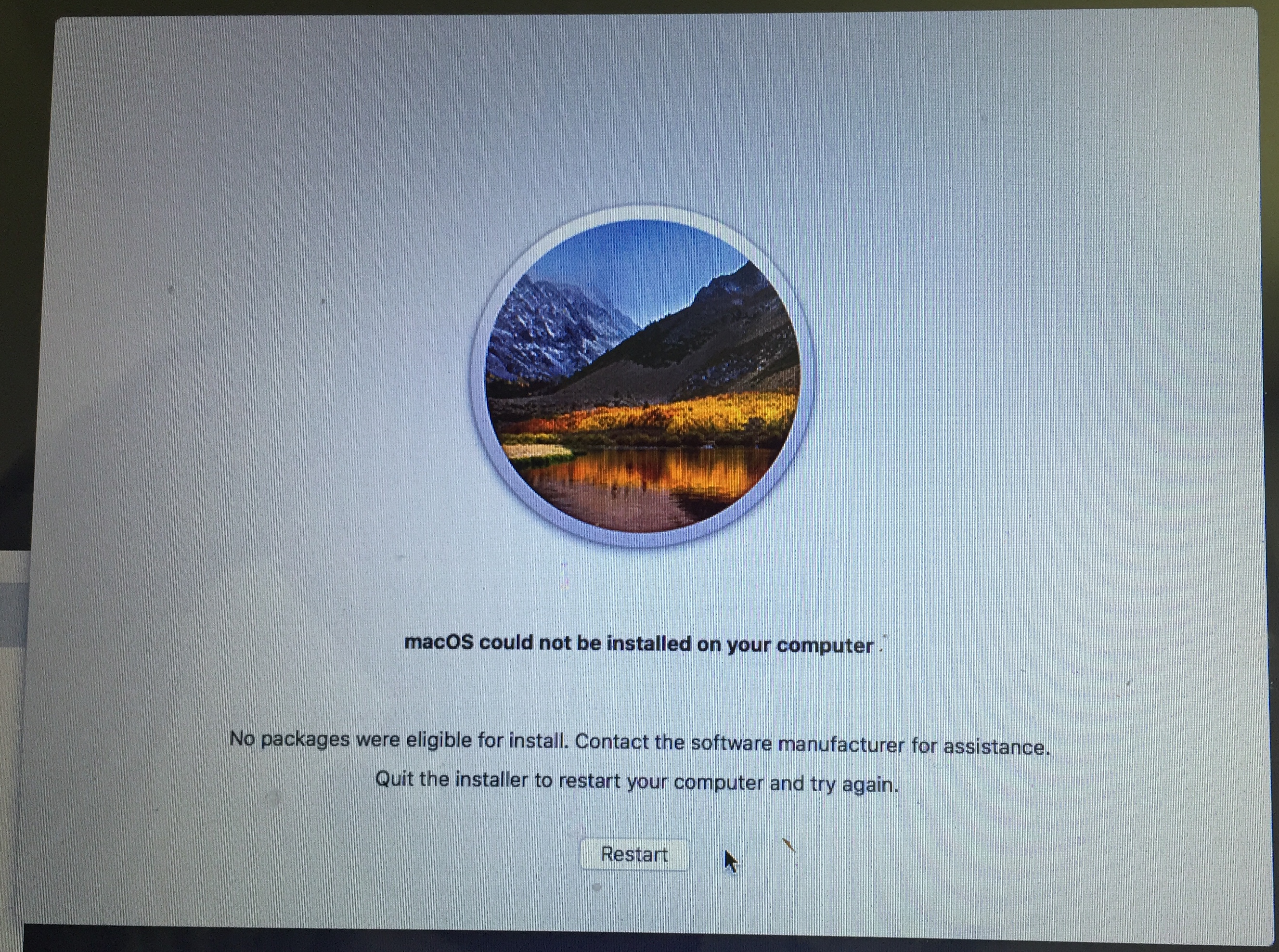- No Packages Were Eligible For Install Os X El Capitan Resetting your PRAM will not only fix this particular OS X install issue, but it can also fix network issues, sound issues, and display issues. So next time your Mac is acting wonky, reset the PRAM and it should be back in working order.
- Was trying to instal el capitan on my macbook, the installation starts and after a few minutes stops and a messaging saying the os x could'nt be install on the computer, please contact the software editor to get help. I called apple and they said they can't give me any tech support, i guess cause my computer is too 'old'.
⌘R - chose reinstall, took approx 2 hours to download, then began installation, broke off & gave me the 'no packages were eligible' message Next tried ⌥⌘R - same deal, 2 hours to download, started install, stopped, no packages message Next tried ⇧⌥⌘R - same process, same result. Here is what we can do: Open disk utility from the Utilities menu or from the Utilities folder. Now you need to select the disk on which you want to install Mac OS X. Select the partition tab in the Disk utility Windows. You will then see a pop up menu from which you have to choose the desired number of partitions you are looking for. Oct 16, 2016 No packages were eligible for install. This is what it looks like in the installer. Upon seeing this I went 'HUH?' Because the installation was from a thumb drive I'd used many times to install Mac OS X (El Capitan) successfully. The above image came from an attempt to install El Capitan. I just got the following message, macOS could not be.

Updates
Important Notes:
Mac os x theme for windows 8 deviantart. Nov 04, 2019 - Install an older version of Mac OS X, (if your machine can go up to el capitan, but if it doesnt install elCap, try installing Yosemite, etc.). No packages were eligible for install.
- Using APFS is REQUIRED in Mojave in order to receive system updates via the normal Software Update method. If you choose to continue using macOS Extended (Journaled) as your filesystem type, you will NOT receive System Updates via System Preferences. If you are not using APFS, you can follow the 10.14.1 installation steps below.
- After applying ANY system update via Software Update, re-applying post-install patches using your Mojave Patcher installer volume will most likely be necessary. If you install a software update and the system fails to boot afterwards, this is what needs to be done.
- Nov 07, 2019 No packages were eligible for install. Facebook; Twitter; Sign in to follow this. No packages were eligible for install. By Himself, November 7, 2019 in AMD Mojave Help Center. Reply to this topic; Start new topic; Recommended Posts. Himself 1 Himself 1.
- Nov 08, 2019 Ive tried this way of installing mojave on my Macbook Pro 8,1 but cant get pass installation. “OS X could not be installed on your computer. No packages were eligible for install”.
- Jul 04, 2016 'OS X could not be installed on your computer. No packages were eligible for install.' Is there something I'm missing here? It used to be perfectly functional under OS X.
10.14.6
10.14.6 can be updated normally via Software Update if using an APFS volume, and will need to be patched using an installer volume created with Mojave Patcher version 1.3.2 or later after installing.

Mac Os X No Packages Were Eligible For Install Free
10.14.5
10.14.5 can be updated normally via Software Update if using an APFS volume, and will need to be patched using an installer volume created with Mojave Patcher version 1.3.1 or later after installing.
10.14.4
10.14.4 adds new changes that ARE NOT patchable by the post-install tool of Mojave Patcher v1.2.3 and older! Before updating to 10.14.4, you you will need to use the latest Mojave Patcher version to create a new installer volume, using the 10.14.4 installer app. Then, update to 10.14.4, either by installing via Software Update, or by just using the installer volume you've created to install.

10.14.3
If you are currently running 10.14.1 or 10.14.2, you can simply use the Software Update pane of System Preferences (if using APFS) to apply the 10.14.3 update. Once the update is installed, you will most likely need to re-apply post-install patches to get the system to boot again. This process is detailed in steps 8 - 10 above. If you are currently running 10.14.0, you'll need to proceed with the 10.14.1 update method described below.
10.14.2
If you are currently running 10.14.1, you can simply use the Software Update pane of System Preferences (if using APFS) to apply the 10.14.2 update. Once the update is installed, you will most likely need to re-apply post-install patches to get the system to boot again. This process is detailed in steps 8 - 10 above. If you are currently running 10.14.0, or are using a non-AFPS volume, you'll need to proceed with the 10.14.1 update method described below.
10.14.1/macOS Extended (Journaled) volumes
Mac Os X No Packages Were Eligible For Install
The Mojave 10.14.1 update does NOT install properly on unsupported machines, and could result in an unbootable OS. If you want to install the 10.14.1 update (and are not currently running 10.14.1), perform the following steps:
• Download the latest version of Mojave Patcher
• Download the installer using the Tools menu of Mojave Patcher
• Create a patched USB installer
• Boot from that, and install 10.14.1 onto the volume containing an older release.
• Once done, apply the post-install patches, and you should now be on 10.14.1.